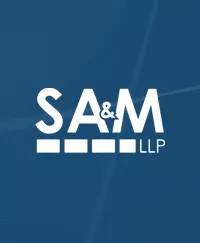 There are more than $25 trillion dollars in U.S. pension plan assets as of December 31, 2016.[1] To a company (for purposes of this article the entity seeking pension plan investment is referred to as the “Company”) seeking investment capital, pension plans may be important potential investors. This blog article identifies two important considerations when seeking pension plan investment: 1. Will the assets of the Company be considered “plan assets”? and 2. Will an investment in the Company result in an income tax liability for the investing plan?
There are more than $25 trillion dollars in U.S. pension plan assets as of December 31, 2016.[1] To a company (for purposes of this article the entity seeking pension plan investment is referred to as the “Company”) seeking investment capital, pension plans may be important potential investors. This blog article identifies two important considerations when seeking pension plan investment: 1. Will the assets of the Company be considered “plan assets”? and 2. Will an investment in the Company result in an income tax liability for the investing plan?
PLAN ASSETS: The first hurdle is whether the Company’s assets will be considered “plan assets” and what are the implications if the Company’s assets are regarded as plan asset? The general rule is in general that a portion of the Company’s assets will be treated as plan assets in percentage that pension plan investment bears to all investment.[2] As having the Company’s assets treated as plan assets turns the Company’s management into plan fiduciaries, plan asset treatment is to be avoided. To avoid a portion of its assets being treated as plan assets of the investing plans, the Company must meet one of the exceptions listed in the plan asset regulation.[3]
- Debt. The plan asset regulation applies to equity and equity-participating debt instruments. Straight debt is not subject to the plan asset regulation.[4] Convertible debt is only treated as equity on conversion unless the conversion feature is more than an incidental feature of the debt instrument[5]. Relying on the determination that the conversion right in a debt instrument is “incidental” would be risky.
- Publicly offered security. The plan asset regulation exempts a class of security that is sold to the public under a registration statement effective under the Securities Act of 1933[6] and that is registered under Section 12(b) or 12(g) of the 1934 Act within 120 days after the end of the fiscal year in which the registration statement was declared effective.[7] To avoid manipulation of this exception, a publicly offered security must have a minimum investment of $10,000 or less and be held by 100 or more investors independent of the Company.[8]
- Operating company. The plan asset regulation exempts equity securities issued by an “operating company”. The plan asset regulation gives no helpful guidance on what would constitute an “operating company.”[9] Instead, the plan asset regulation offers two safe harbors, for a venture capital operating company[10] and for a real estate operating company[11]. A venture capital operating company is a company 50% or more of whose assets are securities of companies in which the company obtains and actually exercises management rights.[12] A real estate operating company is a company 50% or more of whose assets consist of real estate that the company manages and develops.[13] Real estate that is net leased on a long term basis is not considered “managed” for purposes of qualifying for the real estate operating company safe harbor.[14] On the other hand, where the Company has the obligation to maintain and operate the real estate and hires a manager on a short term basis, the Company may still be a real estate operating company.[15]
- No significant participation. Probably the most relied on exception from the plan asset rules is the no significant participation exception, meaning that at all times pension plans hold less than 25% of the value of any class of equity interest in the Company.[16] Investment in the Company’s securities by the Company’s sponsor or managers is ignored. The effect of that computational rule is to make it harder to meet the test for not significant participation. If the Company raises $1,000,000 in capital, $200,000 from a pension plan and $200,000 from management, the pension plan’s investment will be 25% (200,000/800,000), with the investment by management being excluded from the calculation. On the other hand, if a manager were to invest through his IRA or 401K, that investment would be included in the aggregate pension plan investment in the Company.[17
- Tax implications of plan asset treatment. If the assets of the Company are treated as pension plan assets—because none of the exemptions in the plan assets regulation has been met—the managers of the Company will be deemed fiduciaries[18] of the plan assets under management. Use of the plan assets to benefit the Company’s managers would be susceptible of being treated as a prohibited transaction, with the Company’s managers potentially liable for a 15% penalty excise tax imposed on the investment.[19] That tax rate jumps to 100% of the amount involved if the transaction is not reversed by the time the IRS issues a notice of deficiency to the fiduciaries with respect to the prohibited transactions.[20]
- ERISA Fiduciary implications of plan assets treatment. Section 406 of the Employee Retirement Income Security Act of 1974 (“ERISA”)[21] creates a civil cause of action against plan fiduciaries and in appropriate cases against non-fiduciaries who are “parties in interest.”[22] If a plan suffers an economic loss in a transaction that involved a prohibited transaction, the fiduciaries can expect to be required to personally restore those losses. With that understanding, no entrepreneur should want pension plan investors without assurance that the entrepreneur will not be a fiduciary to the pension plan investors, meaning management of the Company should be motivated to avoid plan asset treatment.
UNRELATED BUSINESS INCOME. Another issue for pension plan investors, completely apart from the prohibited transactions discussed above, is the determination of whether an investment in a Company will generate unrelated business income (“UBI”)[23] for the pension plan or exempt organization investor. As noted above, an operating company is not subject to plan asset treatment, but an operating company may well generate unrelated business income.[24] Income from a business that an exempt organization or pension plan operates or invests in is treated as UBI. UBI less allowable deductions results in unrelated business taxable income, upon which the unrelated business income tax is imposed[25].
Income from dividends, interest, royalties, rents and capital gains are excluded from UBI[26]. Rents of personal property and rents based on the income or profits of any person are includible in UBI.[27] A portion of dividends, interest, royalties, rents and capital gains derived from debt-financed property will be included in UBI.[28]
The allocation of net profits to an investing pension plan by a limited liability company (“LLC”) or other partnership that itself conducts an operating business will be treated as UBI to the investing Plan.[29] A plan really has three choices when considering an investment, (a) avoid an investment in an active business through a pass-through entity like an LLC, (b) invest in an active business through a pass-through entity and pay the tax on the UBI, or (c) form a wholly-owned C corporation to hold the interest in the operating LLC (generally known as a blocker corporation). Where a sponsor is promoting an investing in an operating business through a pass-through entity, the sponsor itself may form the blocker corporation through which plans, exempt organizations and foreign taxpayers may invest.
As a general rule, the purchase of an interest in an investment that would otherwise be exempt from UBI, for instance because it generates royalties, dividend, interest or rents, by incurring debt or buying subject to debt will cause a portion of the income to be taxed as UBI.[30] The determination that an investment constitutes “debt financed property” that will cause a portion[31] of the income from the investment to be UBI can be made at the investing plan level and at the investment level. For example, if a plan borrows to buy a corporate bond, a portion of the interest from that bond will debt-financed property. In addition, if a plan invests in an LLC that borrowed to acquire an asset, the debt-financed character of a portion of the income will be passed through to investing plans.
Section 514 provides a limited exception from acquisition indebtedness treatment for mortgage debt secured by real property owned by a “qualified organization”. The term “qualified organization” includes (a) a charitable educational organization, (b) a pension trust, (c) a corporation formed to hold real estate for a pension plan or charitable educational organization, and (d) a church retirement income account.[32] If a partnership or LLC will acquire real estate subject to mortgage debt, as is typical, the sponsor may make the investment more attractive to potential pension plan investors by satisfying the requirements for partnerships to avoid debt financed income for investing plans in the LLC’s operating agreement or the limited partnership’s limited partnership agreement.[33]

For more information about our Tax & Estate Planning practice, contact Michael Shaff at
______________________________________________________________________________
[1] https://www.ici.org/research/stats/retirement/ret_16_q4
[2] 29 C.F.R. §2510-3.101(a)(2)(second sentence); the first sentence of subsection (a)(2) establishes the “general rule” that a pension plan’s assets consist of its investment but not the underlying assets of the entity. The second sentence relegates that rule to being an exception.
[3] 29 C.F.R. §2510.3-101 will be referred to as the “plan asset regulation” in this article.
[4] 29 C.F. R. §2510-3.101(b)(1).
[5] 29 C.F.R. §2510-3.101(j)(example 1).
[6] As Regulation D is an exemption from registration pursuant to Section 5 of the Securities Act of 1933, securities offered pursuant to Rule 504 or 506 would not satisfy this part of the plan asset regulation.
[7] 29 C.F.R. §2510-3.101(b)(2).
[8] 29 C.F.R. §2510-3.101(b)(3) and (4).
[9] 29 C.F.R. §2510-3.101(c)(1): “An ‘operating company’ is an entity that is primarily engaged, directly or through a majority owned subsidiary or subsidiaries, in the production or sale of a product or service other than the investment of capital.”
[10] 29 C.F.R. §2510.3-101(d).
[11] 29 C.F.R. §2510.3-101(e).
[12] 29 C.F.R. §2510.3-101(d)(3).|
[13] 29 C.F.R. §2510.3-101(e).
[14] 29 C.F.R. §2510.3-101(j)(example 7).
[15] 29 C.F.R. §2510.3-101(j)(example 8).
[16] 29 C.F.R. §2510.3-101(f).
[17] 29 C.F.R. §2510.3-101(f)(1).
[18] 26 U.S.C. §4975(e)(3).
[19] 26 U.S.C. §4975(a)).
[20] 26 U.S.C. §4975(f)(2).
[21] 29 U.S.C. §1106
[22] Harris Trust Savings v. Salomon Smith Barney Inc., 530 U.S. 238 (2000). Salomon Smith Barney acted as broker for a pension plan’s fiduciary, executing trades that constituted self-dealing prohibited transactions. (Id.) The Supreme Court found that although not a fiduciary, Salomon Smith Barney was a party in interest and therefore could be sued for the plan’s actual damages, effectively making the defendant the insurer of every transaction that the fiduciaries engaged in.
[23] Internal Revenue Code (I.R.C.), 26 U.S.C. §511-514.
[24] I.R.C. §512(a).
[25] Id.
[26] I.R.C. §512(b).
[27] I.R.C. §512(b)(3).
[28] I.R.C. §511(a)(1).
[29] I.R.C. §512(c)(1).
[30] I.R.C. §514(a).
[31] In short, the ratio that average acquisition indebtedness bears to the average basis of the debt financed property will determine the portion of the income from the debt financed property that will be UBI. As the amount of debt and the adjusted basis of the debt-financed property change, the portion of the income treated as UBI will change. I.R.C. §514(a).
[32] I.R.C. §514(c)(9)(C). The exemption for these organizations may reflect Congress’s determination that pension plans and certain educational institutions often invest in leveraged real estate.
[33] I.R.C. §514(c)(9)(E).

